If you’re new to the agroforestry project on the 48 acre Broadlears field at Dartington, then I would suggest referring to the copiously documented backstory elsewhere first – this blog is already too long without including past details.
If you’re familiar with our multi-cropping and multi-tenanted scheme then here are all the things we’ve learnt thus far – combining feedback largely from me, jotted down in the process of coordinating the project, but also the licensees, the farm tenant, the contracted tractor drivers and our agent.
Gallery: Agroforestry field timelapse
I made no claims, prior to commencing this project, of particular skills in this area, or in fact any skills in this area – the primary resource I had at my disposal was time. If you read our ‘learning’ and shake your head in dismay at the obviousness of it all that’s fine – I envy you your expertise and look forward to learning from you sometime – but if you’ve wondered about how agroforestry might work for you but haven’t yet felt brave enough to have a go, then hopefully this will be of some use to you.
Harriet
The top few pointers….
- I wish I was omniscient but actually the more I talk to people about their agroforestry work – experienced and knowledgeable people, the people who are invited to talk at conferences and you think “wow, that’s so inspiring, I wish I had my stuff together the way they have their stuff together” – the more you realise that actually everyone is pretty much winging it. To quote one of those people on my realization that everyone is winging it: “It’s part of the package of being pioneers! I think the important bit is being able to share these experiences so we can learn from each other.”
- The other great thing is that it didn’t matter that I’m not omniscient. The benefit of multiple partners is that it makes the project more socially and economically resilient. Everyone comes bringing the skills relevant to the crop they’re going to manage or the job they’re going to do. So instead of one farmer, with say 20 years of experience, you end up with multiple partners with 60, 80, 100 years of combined experience across multiple specialities. You just have to listen to them and facilitate them having a chance to listen to each other. It also makes it more economically resilient because while everyone brings their own markets for their own crops, by working together in future, accessing different markets, everyone has the potential to grow their market reach.
- Because we didn’t actually set out to develop a new model of agroforestry involving five different partners – it just happened organically while we were trying to do some regular agroforestry – we rarely had more than two or three participants together for discussion at any one time. If one was going to intentionally deliver agroforestry with a variety of partners, contractors and consultees involved one should definitely get everyone together throughout the project, particularly for the design process. That way everyone would be aware of everyone else’s skills, interests and preferences.
Advice we probably should have stuck to but didn’t…
- Martin Crawford of The Agroforestry Research Trust – suggested ‘nitrogen fixing’ trees and a wind buffer. We didn’t plant either because we thought we had insufficient space to fit all the crops in at the minimum they required to commercially viable – and we were trying not to squeeze row widths too much. We also put the Sichuan Pepper, in the final layout, into the windier part of the field to try and make that tough crop the buffer for the apples.
- Stephen Briggs, Abacus Agriculture –when we contracted him to help with the design, Stephen proposed 27m tree to tree width spacing. We tried to do this, but for reasons of space outlined above ended up at 19m/21m (we did also get advised to plant at 12m and at 50m by other also expert people). Planting at 27m tree to tree would have meant arable rows of 24m, which would then have been divisible by either 3/4m farm machinery – this would have been preferable.
Planning stages…
- Start gathering baseline data (soil/birds etc.) much earlier on in the process to evidence the impact of the project.
- One of the licensees was very quiet during the design process whereas another kept requesting changes to layout and license. At the time this caused more work, as it meant we had to redraw the map a lot, and it delayed the project, meaning we missed our window to under sow the tree strips with a nectar rich mix for pollinators. However, when the field was marked up ready for planting, the quiet licensee rocked up expecting to be able to widen the spacing of trees across the width of their tree rows at the last minute, as they went in the ground. We had to explain that could not be done because it would impact on the arable crop between rows. So having fastidious licensees is, it transpires, preferable. Furthermore, because we’d had to revise the license several times to make absolutely sure it was right, we had a document that disincentivises one licensee from carrying out their activities in a way which might negatively impact another field user. Not that we needed to refer to that – we just needed to explain – but it’s reassuring that there is that legal safety net.
Gallery: evolution of agroforesty field maps over time
- The licence started out with a lot of detail regarding access. This was cut down, but if parties are relying on the contract/licence to govern how they use the site then things are not starting out well. There has to be a lot of cooperation with this type of arrangement so getting people that get on with each other and have a loose contractual framework seems to be the best way forward.
- One of the more challenging discussions around the license was compensation i.e. what happens/who pays if for whatever reason the plug gets pulled on the project. This is a sensitive subject; trees are long term investments which increase in value over time – whereas normally investment items (farm buildings etc.) decrease in value, so there was effectively a financial incentive for our tenant to wait until the trees were mature and then boot the tree licensees off after they’d done all the hard work at the beginning. Because of that, the usual straight line of depreciation method, on which agreements usually base compensation rates, was only partly applicable. Consequently we developed our own, somewhat more complicated compensation formula. This is yet to be tested, and hopefully never will be, but could be a useful model for any future agreements of a similar ilk. The compensation terms did also require the Trust, as the landowner, to back up our tenant’s agreement and this could be something which other land owners may not be willing to do.
Planting stage…
- Don’t forget to check for utilities! I.e. try to avoid ploughing through water pipes and power cables, not that we did because thankfully we have a very sensible water technician and tractor driver who’ve both been working the estate for years. If you don’t have those get a map of utilities which might be in the area and check that first.
- Subsoiling the tree rows and the parameter of the tree rows as a means of marking out the field layout worked brilliantly. It marked the rows really clearly and made planting 100% easier.
Gallery: Subsoiling rows as a means to draw the map onto the agroforestry field
Using a tape measure to check that the tractor’s GPS system is getting the distance between rows right (which it was)
- Generally, don’t assume that because you are fixating about the details of a project everyone else is as well. Even if you’ve shared all the information with them there’s no guarantee they read/understood/ remember/care because at the end of the day most people have quite a lot on their plates. Examples include Huxhams Cross Farm planting their trees at the very end of each row, thereby shading the arable crop and providing no buffer between the first tree in each row and the cutting of the arable crop. The elderflower and peppers were all planted at a distance of 50% of the tree space into the row e.g. if tree spacing is 4m then first tree planted 2m into the row.
- Somewhat following on from that, the more people involved the less likely it is that the specifics will trickle down to all members of staff or to volunteers. For example, we came across a few Luscombe staff driving through Jon’s arable crop – rather than down their tree strip margin Luscombe rent from Jon which includes access space – because they don’t know that’s not an ok thing to do, nor how the arrangement works. Luscombe’s senior team did address when it was mentioned and it hasn’t happened since.
- To quote one of the licensees, “It was pretty daunting task to plant up such a huge space, particularly for the growers who had not planted on that scale before, so we needed to get a good team together and lots of nice coffee and biscuits. It was in the end – as it is for many of these things, ‘not as bad as it seemed’ and all got planted in record time.”
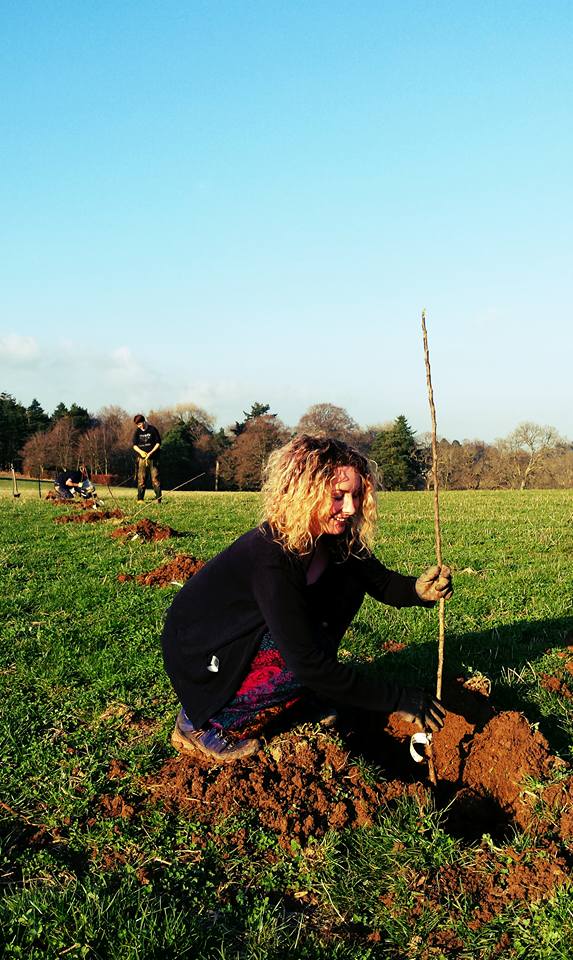
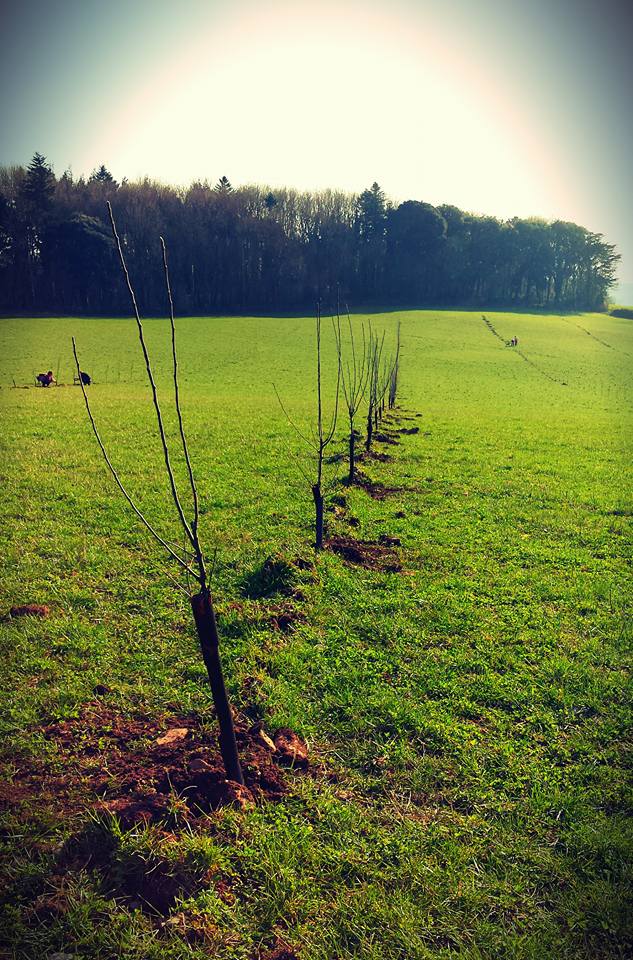
The Sichuan pepper…
- Martin Crawford said that at two years old (the age of the whips we have planted), the Sichuan pepper trees should have sufficient bark to be safe from slugs and sufficient thorns and flavour to put off deer and rabbits. This is probably true but apparently deer and rabbits need to try something before they decide they don’t like it. So we didn’t guard the trees, and then we did because we weren’t sure at what point all the deer locally would all have tried it, and then we stopped because they seemed to have tried enough and ceased eating it.
- The Sichuan pepper whips were two metres tall and thin like a bramble. I’m worried about the impact of the wind on them on such an exposed site. For the second batch (autumn 2017) we’ll be getting some one-year-old whips and will run the gamut of wind versus slugs.
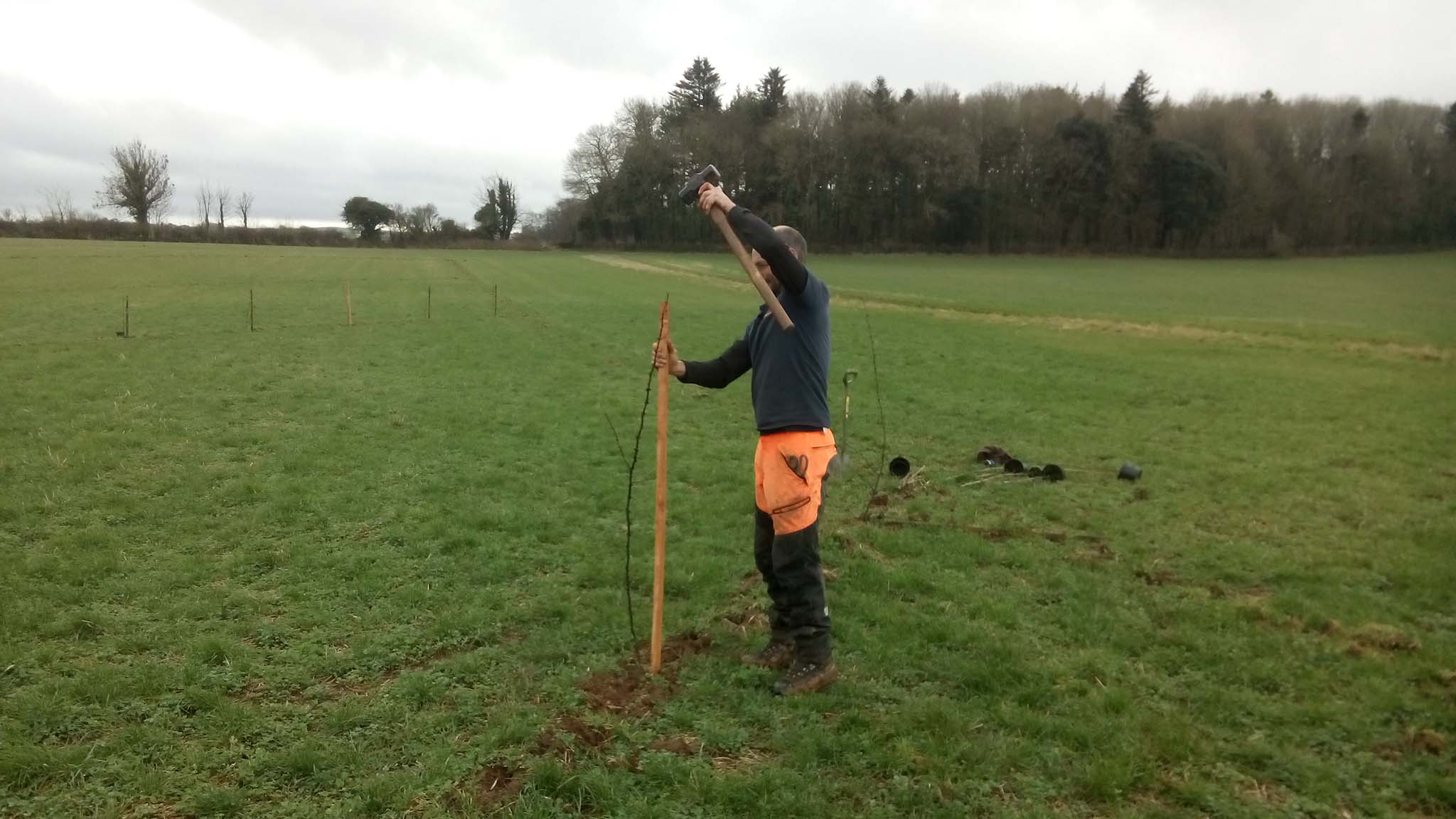
What the guys driving the tractors had to say about it, post-first silage cut…
- “It would be good if everything in the field was easily visible as when you can see the trees it’s relatively easy to run alongside them.”
This point specifically referenced the elderflower and the wooden stakes I’d put in the field to mark out this autumn’s pepper planting as the clover grass ley had grown taller than both, rendering them virtually invisible. Consequently we lost a few wooden stakes when the field was cut but thankfully it looks like the elderflower was spotted in time and came through ok. The wooden stakes is a bit of a mea culpa on my part, I should have used larger ones to mark my future pepper planting spots. As to the elderflower, though they don’t need bigger stakes for support, we should probably have realised the elderflower needed some clear demarcation.

However, this is also a communications issue. Whilst the chap cutting the field knew about the agroforestry no one had thought to give him a map so he had a better idea of the layout of the rows. Similarly our farm tenant had forgotten about the wooden stakes hiding in the grass and so didn’t communicate a warning.
- “That in laying out the tree rows at an angle to the central track through the field our design means that the tractors have to turn more frequently than they would have needed to if the tree rows ran parallel to the central track, making it less efficient.”

We did consider this in the design stage of the field, in fact it was the initial layout proposed by the Woodland Trust. However, our concern was that, whilst for silage and arable work tractors are generally only going into the field in good weather, for harvesting and pruning the trees in future, vehicles would likely be accessing the tree rows in autumn and winter, under wetter soil conditions.
If we’d put the tree rows in parallel to the track then that would have meant to access them vehicles would have needed to drive up and down the side of the field to get to each individual row. In inclement weather this repeated use could cause a lot of damage to the ground on the field sides making it unsuitable for silage or arable cropping. By designing the field so you can access each tree row from the central hard-standing track we hope to mitigate the impact of harvesting and pruning activities during autumn/winter. It’s one of the compromises of the design.
- “That having the tree rows at a, roughly, 45° angle from the central track makes the field more awkward to cut.”
We planted the trees north to south, in line with the horticultural convention of planting intended to maximize light to the crop – this is why they’re not at a 90° angle from the track. Perhaps this is an area where we might have given greater consideration to compromising in order to favour tractor access but we prioritised making sure the trees got the best light levels possible. With some crops this may be less of an issue, for timber crops a bit of shade may be a benefit, but for this field it is particularly important that the apple crop gets top light levels. Even then, the climate of the South West generally may mean the apples are more suitable for juicing than being sold as eating apples.
Ongoing…
- Huxhams Cross planted largely main crop apples in this field, keeping more sensitive varieties and fruits closer to home on their own land because it’s more convenient to check them there. Nonetheless these apples will still need checking on so a system or route will need to be devised to make sure this happens as part of a routine.
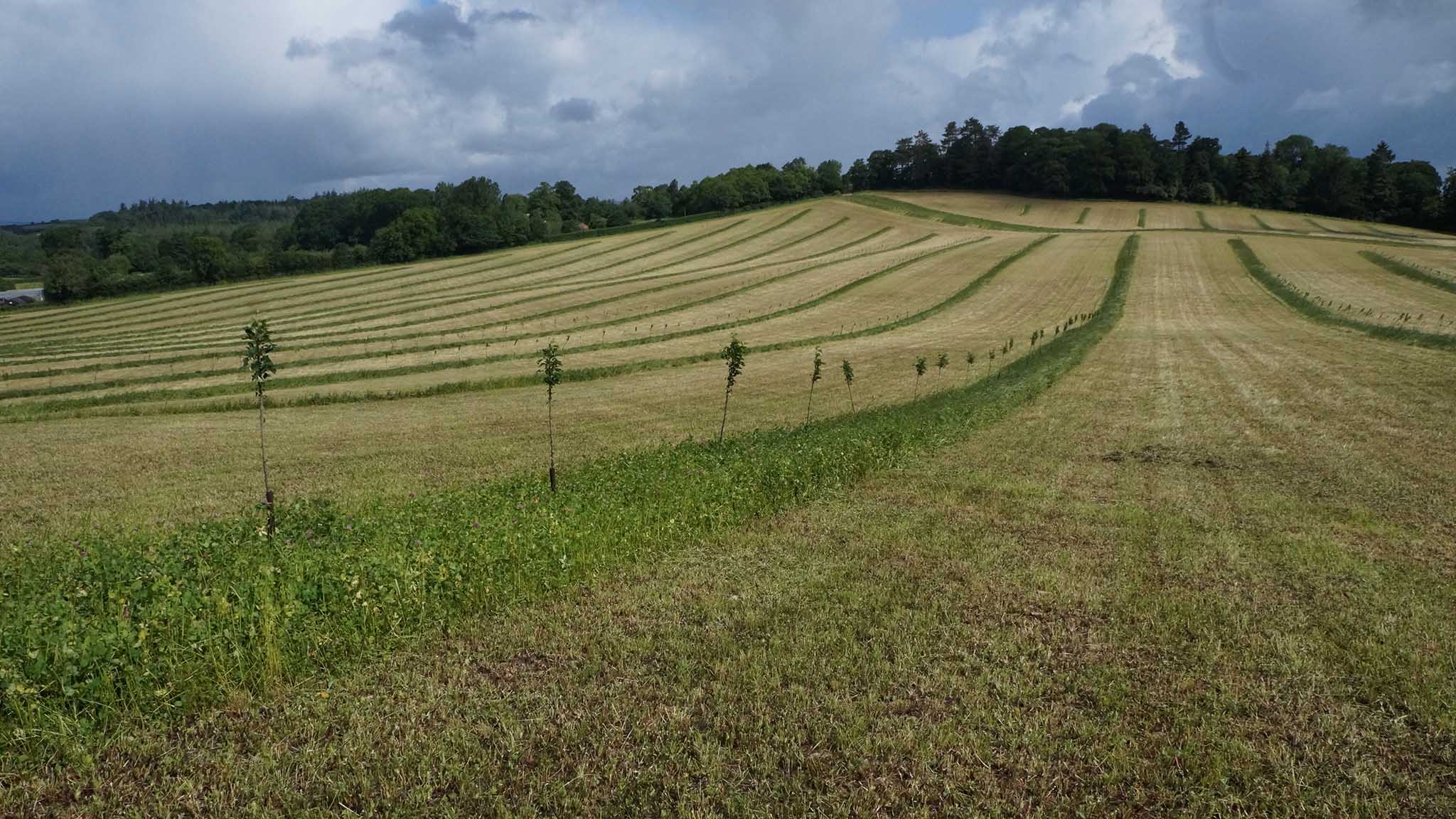
- One of the big challenges of developing the license was trying to make sure that it was fair – and that tends to be very subjective. The fairness of the financial arrangements was particularly difficult, taking in impacts for the main farm tenant – yield, labour, administration, Basic Payment Scheme, potential increase in contractor costs for working a more challenging field – and balancing that against what’s affordable for the licensees, their upfront investment and long term payback. It’s still too early to know if we’ve got that element right. There’s no comparable project and the rent we set may or may not be what the market can stand, we’ll need to go through a rent review process with data relating to yields and costs a bit further into the project to see how it’s all stacking up.
- This isn’t so much a learning as a pondering but in terms of thinking about what makes good partners for such a project I look at the businesses we have involved. Are they interested because they think in generations? Lots of them would like to hand their businesses on to their children, should their children want them. Alternatively, is it that they’re not afraid to be different or innovative? Huxhams Cross Farm is happy to embrace both biodynamic and permaculture-based approaches which is not common in agriculture. Or is it that you have to be both – that embracing innovation is what is required for a business to stay the course over generations?
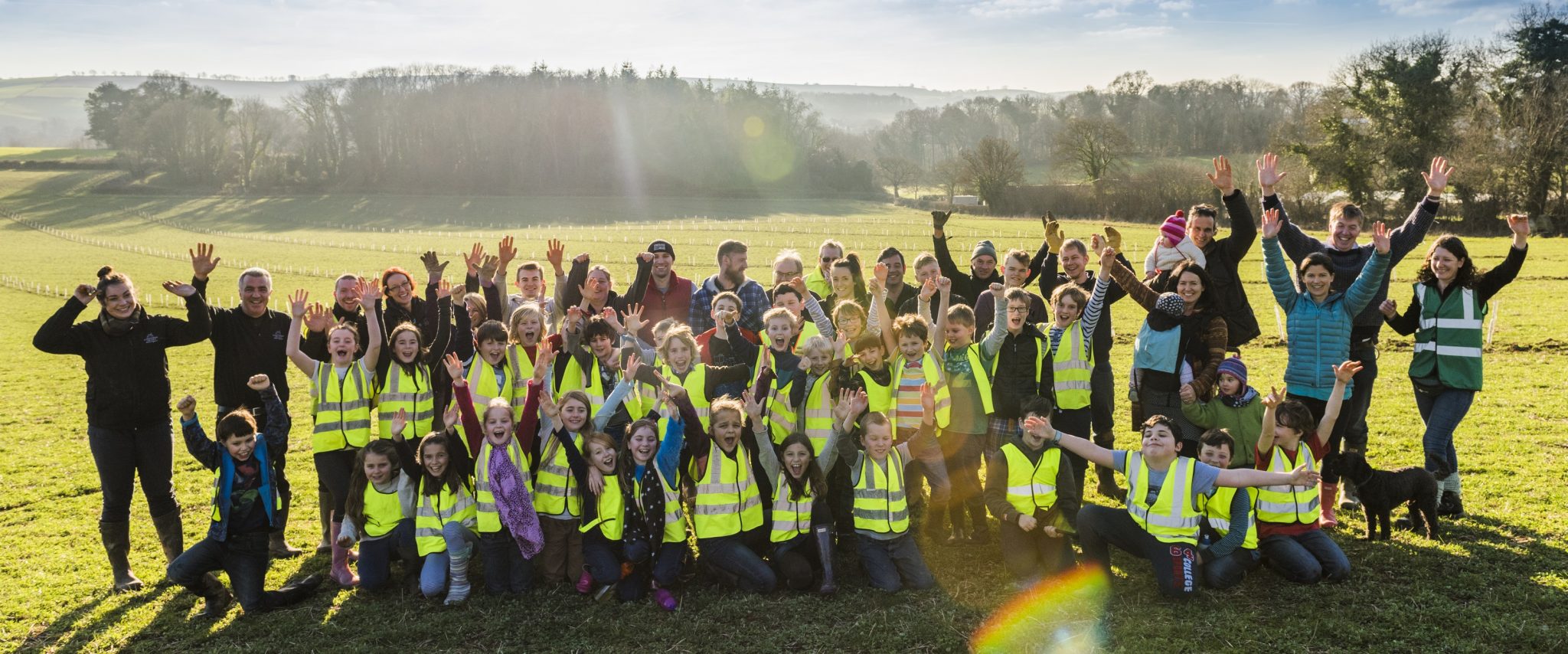
Things we’d perhaps do differently next time…
- Wish I’d had the experience/knowledge to take a more permaculture design approach. Post-planting, and now having completed a course in permaculture design, I keep taking note of things like frost pockets and areas of shade that I hadn’t properly observed before. I wish I’d done more observation work in the field, mapping out and surveying some of the other details first – maybe marking out some test locations with stakes and observing those rather than relying on people designing in their heads. Huxhams Cross did take a more permaculture approach and it’s been demonstrably beneficial.
- We should have put more crops in. We did intend to under plant the trees with a nectar mix to attract pollinators to the trees, and the Sichuan peppers were planted with a mycorrhizal mix of edible fungi but in reality we’re still underutilizing a lot of the space. On the plus side we can still retroactively go back in and plant under the pepper and apples trees should we wish (elderflower are more densely planted). Huxhams Cross are already in the process of planting fennel under their apples, which is something they have done previously, to attract pollinators.
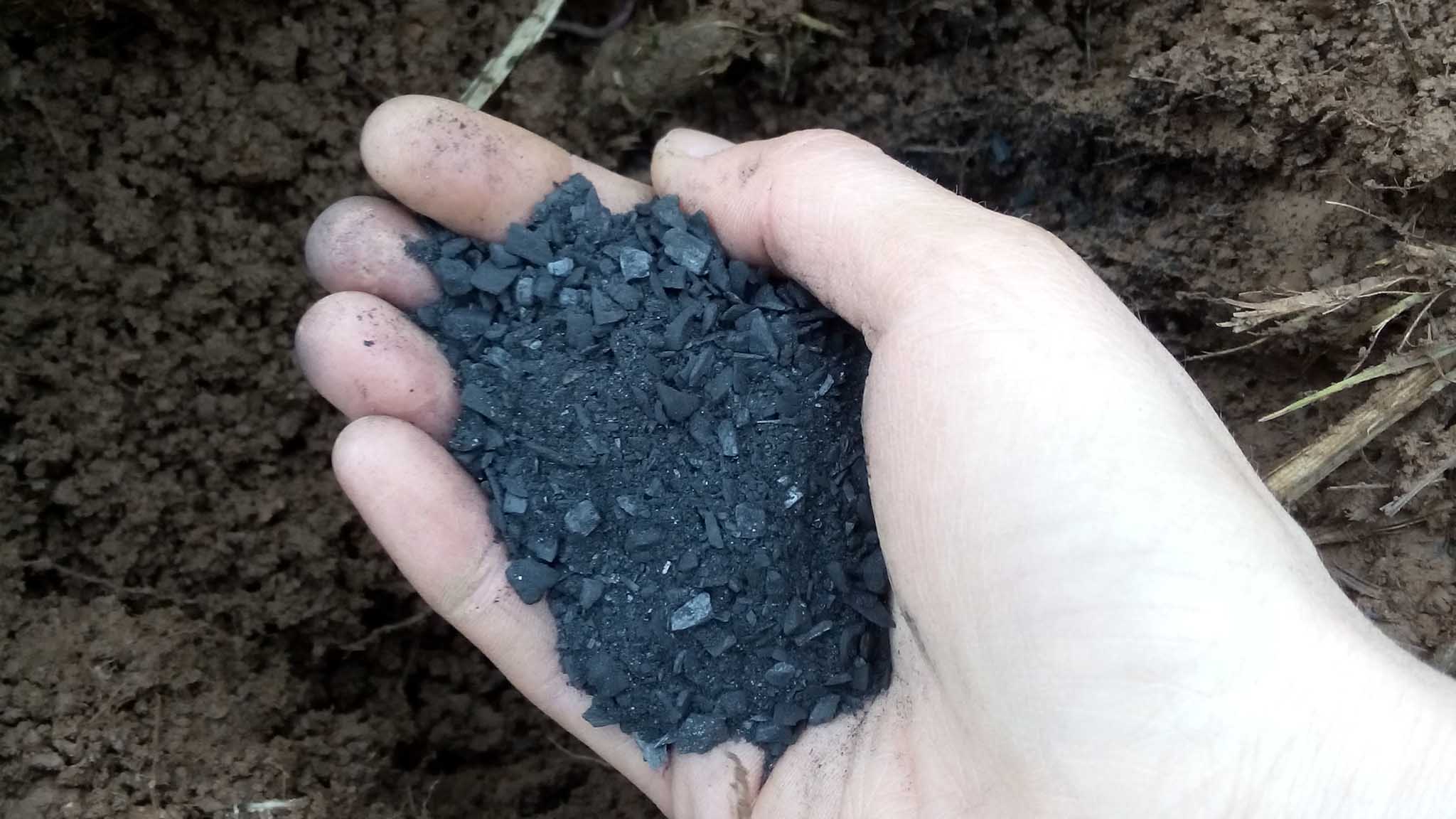
- We should have got John Millman Agricultural Contractors, who do most of the arable work on the estate, involved in the design stage. Jon, our farm tenant, was sure the rows needed to be divisible by 4 – but if we’d gone direct to the man who drives the tractor we would have known much earlier in the process that it was more important the rows be divisible by 3. As it is, at the last minute, we made the arable rows 15m instead of 16m. Hopefully, it will all work out alright.
Gallery: And finally…what the field looks like now

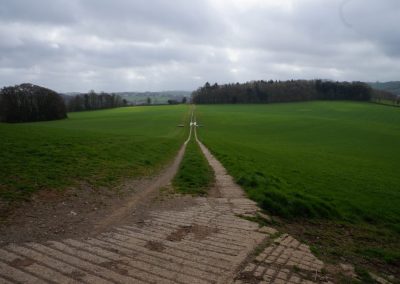
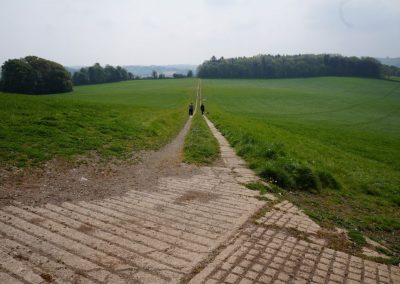
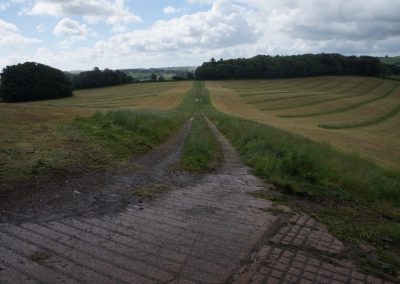
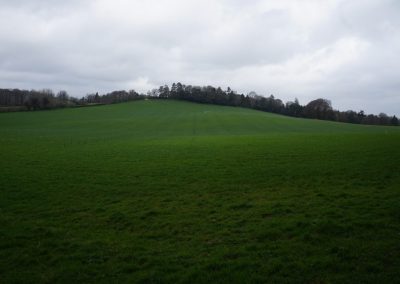
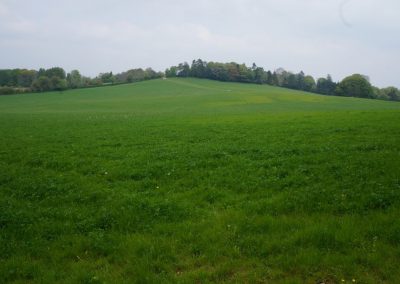
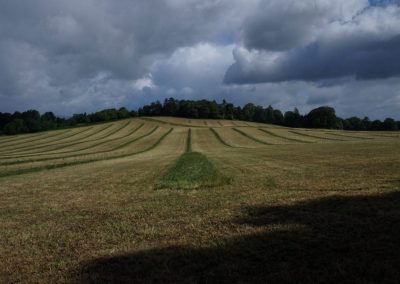
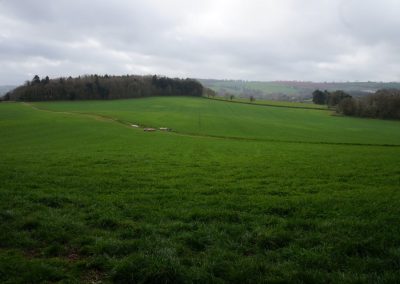
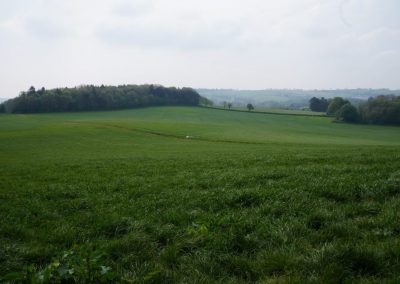
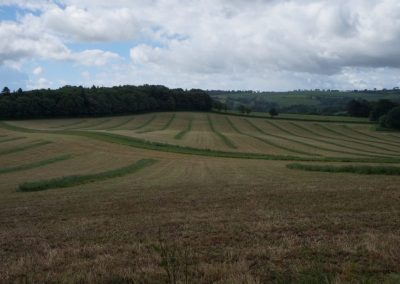
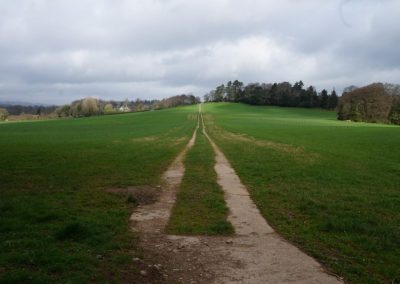
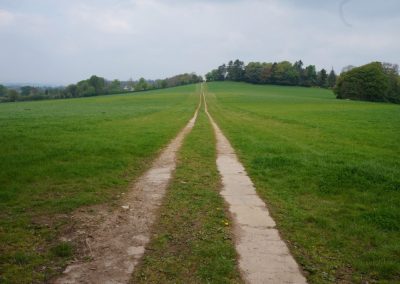
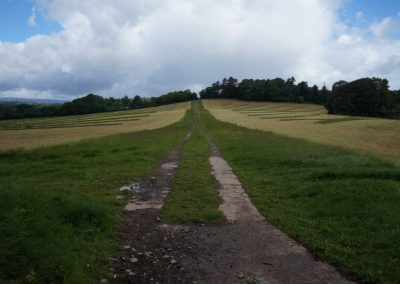
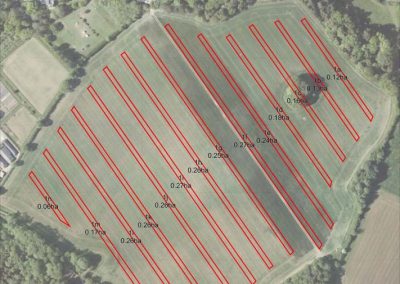
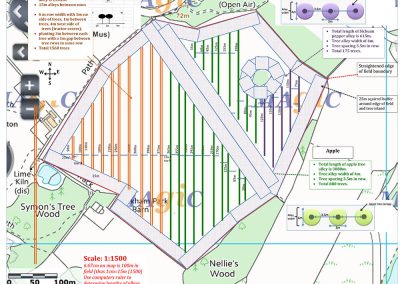
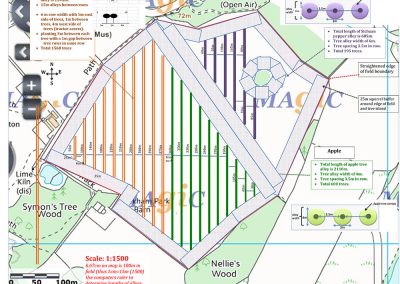
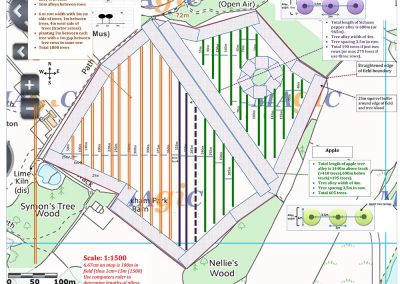
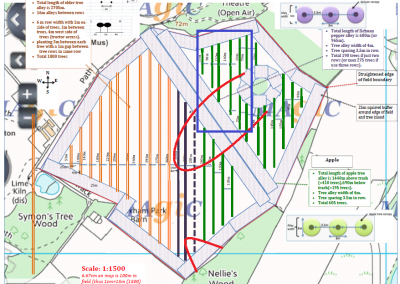
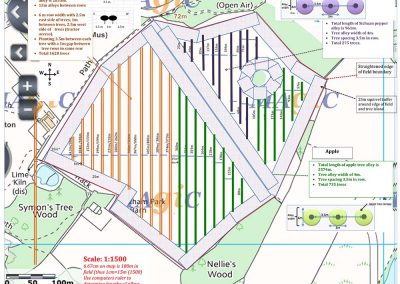
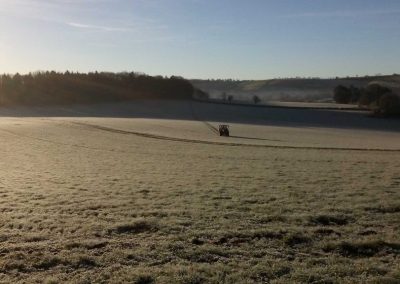
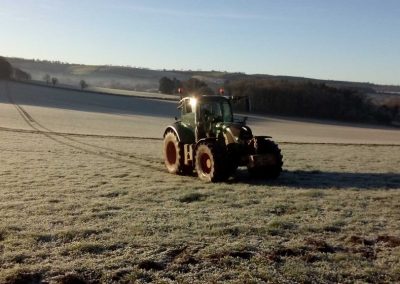
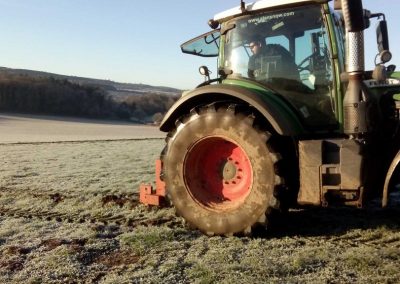
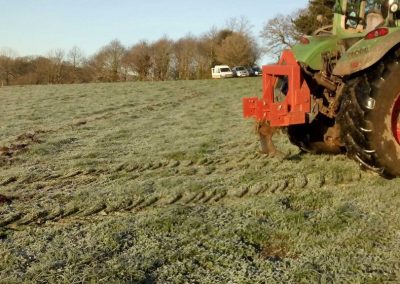
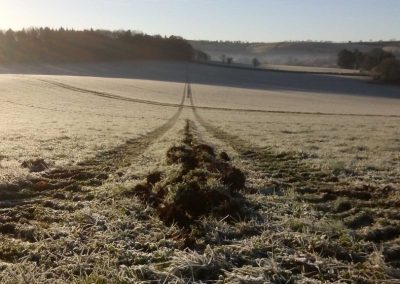
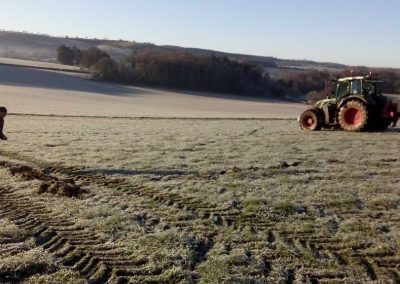
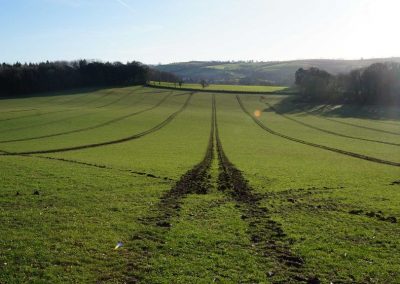
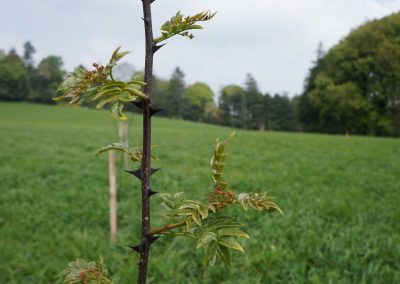
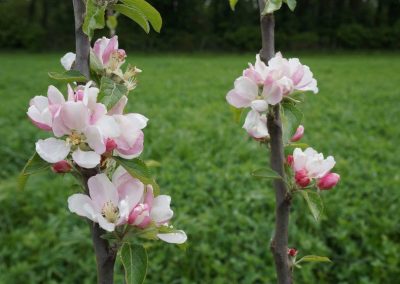
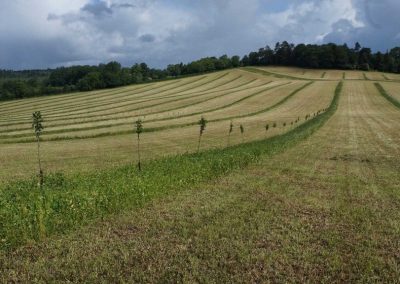
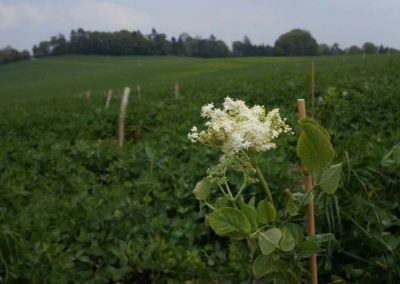
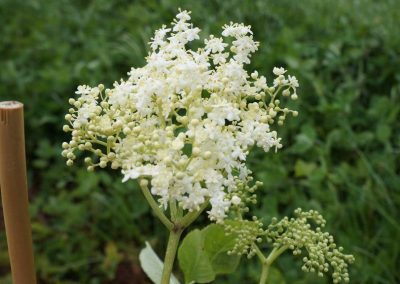
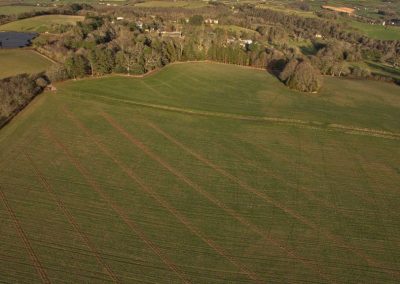
Well done Harriet, what an amazing project – interesting to hear about the ‘lessons learnt’
excellent, very interesting to a totnes resident without a green finger
Excellent information for farmers considering a move to an agroforestry system. Well done Harriet.
Bravo – Agroforestry, 3D cropping and multifunctional land use…..welcome to a burgeoning number of farmers and landowners that recognize the benefits of Agroforestry